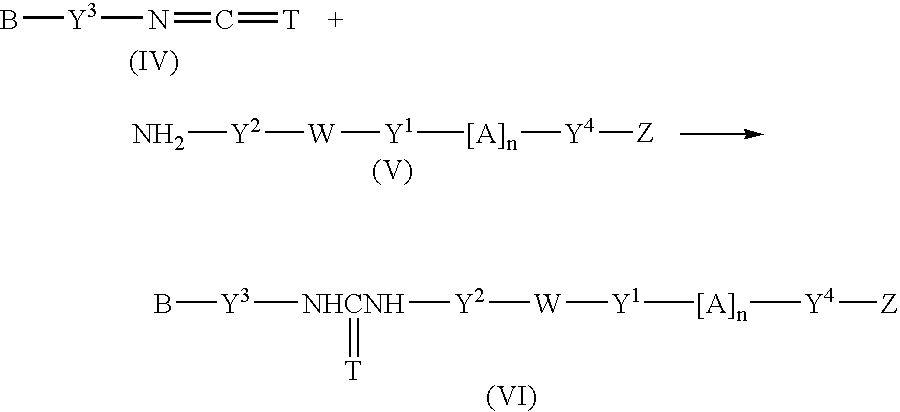Fluorescent group-containing carbodiimide compound precursor, fluorescent group-containing carbodiimide compound and methods for producing them
a carbodiimide compound and compound technology, which is applied in the preparation of isocyanic acid derivatives, organic chemistry, luminescent compositions, etc., can solve the problems of complex operation and inability to introduce fluorescent substances into naturally occurring nucleic acids
- Summary
- Abstract
- Description
- Claims
- Application Information
AI Technical Summary
Benefits of technology
Problems solved by technology
Method used
Image
Examples
example 1
[0150] (1) Production of Fluorescent Group-Containing Carbodiimide Compound Precursor Represented by the General Formula (I)
[0151] N-(3-Morpholinopropyl) isothiocyanate (1.68 g, 10 mmol) was dissolved in 15 ml of dry methylene chloride, and cooled on a water bath. To the solution, 6-aminohexanol (1.17 g, 10 mmol) was added, and the mixture was stirred overnight at room temperature. After addition of water to the reaction mixture, the mixture was extracted with methylene chloride. The extract was dried over anhydrous magnesium sulfate, filtered through Celite, and concentrated to obtain Compound (I-I-A) (2.7 g, yield: 95%). The NMR spectrum data are shown below.
[0152] .sup.1H-NMR (CDCl.sub.3): .delta.=1.35-1.85 (m, 12H), .delta.=2.40-2.60 (m, 6H), .delta.=3.45 (br, 2H), .delta.=3.65 (t, 2H), .delta.=3.75 (t, 4H) 13
[0153] Then, the obtained Compound (1-1-A) (2.0 g, 4.87 mmol) was dissolved in dry DMF (5 ml). Methyl iodide (0.691 g, 4.87 mmol) was added to the solution, and the mixture...
example 2
[0168] (1) Production of Fluorescent Group-Containing Compound Represented by the General Formula (VIII)
[0169] 2-[2-[3-[[1,3-Dihydro-1,1-dimethyl-3-(4-sulfobutyl)-2H-indol-2-ylid-ene]ethylidene]-2-phenoxy-1-cyclohexen-1-yl]-ethenyl]-1,1-dimethyl[3-propy-l isothiocyanate] 1H-benz [e]-indolium salt (400 mg, 0.502 mmol, produced by LI-COR) was dissolved in dichloromethane (10 ml). After the solution was cooled to 0.degree. C., N-3-(dimethylaminopropyl)amine (76.9 mg, 0.753 mmol) was gradually added thereto, and the mixture was stirred at room temperature for 1.5 hours. After this reaction solution was concentrated, ether / methanol was added, and the mixture was decanted to obtain Compound (II-I-A) (402 mg, yield: 89%). The NMR spectrum data are shown below.
[0170] .sup.1H-NMR (CDCl.sub.3): .delta.=1.20-2.40 (m, 14H), .delta.=2.25 (s, 6H), .delta.=2.45 (t, 2H), .delta.=2.65-3.05 (m, 4H), .delta.=3.65-3.95 (m, 4H), .delta.=4.45 (t, 2H), .delta.=6.13 (d, 1H), .delta.=6.35 (d, 1H), .delta.=6...
example 3
[0176] (1) Production of Fluorescent Group-Containing Compound Represented by the General Formula (VIII)
[0177] Cy3.18.OSu (200 mg, 0.175 mmol) produced by referring to Japanese Patent Application Laid-open No. 9-325147 and Ratnakaer B. Mujumdar et. al., Bioconjugate Chem., 4, 2, 105-111 (1993) was dissolved in DMF (5 ml). After the reaction solution was cooled to 0.degree. C., N-3-(dimethylaminopropyl)amine (71.4 mg, 0.698 mmol) was gradually added thereto, and the mixture was stirred at room temperature for 12 hours. After this reaction solution was concentrated, ethyl acetate / methanol was added thereto, and the mixture was decanted several times to obtain Compound (III-1-A) (170 mg, yield: 87%). The NMR spectrum data are shown below.
[0178] .sup.1H-NMR (DMSO): .delta.=1.30-1.60 (m, 12H), .delta.=1.70 (s, 12H), .delta.=2.05 (t, 4H), .delta.=2.10-2.30 (m, 8H), .delta.=2.15 (s, 12H), .delta.=2.95 (q, 4H), .delta.=4.12 (t, 4H), .delta.=6.54 (d, 2H), .delta.=7.36-7.95 (m, 6H), .delta.=8...
PUM
| Property | Measurement | Unit |
|---|---|---|
| pH | aaaaa | aaaaa |
| temperature | aaaaa | aaaaa |
| pH | aaaaa | aaaaa |
Abstract
Description
Claims
Application Information
 Login to View More
Login to View More - R&D
- Intellectual Property
- Life Sciences
- Materials
- Tech Scout
- Unparalleled Data Quality
- Higher Quality Content
- 60% Fewer Hallucinations
Browse by: Latest US Patents, China's latest patents, Technical Efficacy Thesaurus, Application Domain, Technology Topic, Popular Technical Reports.
© 2025 PatSnap. All rights reserved.Legal|Privacy policy|Modern Slavery Act Transparency Statement|Sitemap|About US| Contact US: help@patsnap.com



